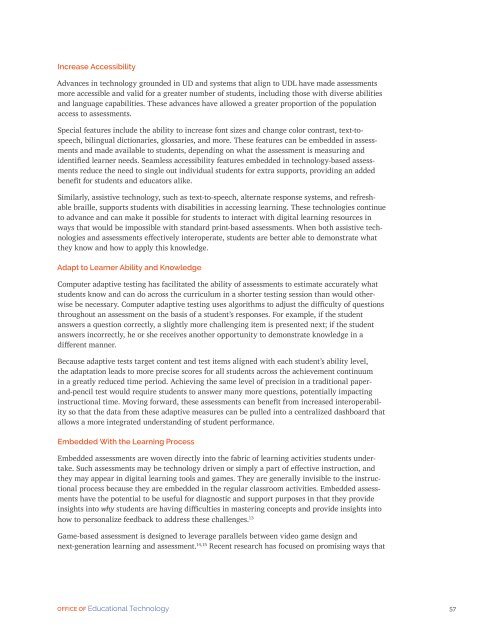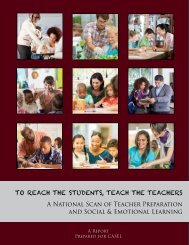Future Ready Learning
7m3sdJ
7m3sdJ
You also want an ePaper? Increase the reach of your titles
YUMPU automatically turns print PDFs into web optimized ePapers that Google loves.
Increase Accessibility<br />
Advances in technology grounded in UD and systems that align to UDL have made assessments<br />
more accessible and valid for a greater number of students, including those with diverse abilities<br />
and language capabilities. These advances have allowed a greater proportion of the population<br />
access to assessments.<br />
Special features include the ability to increase font sizes and change color contrast, text-tospeech,<br />
bilingual dictionaries, glossaries, and more. These features can be embedded in assessments<br />
and made available to students, depending on what the assessment is measuring and<br />
identified learner needs. Seamless accessibility features embedded in technology-based assessments<br />
reduce the need to single out individual students for extra supports, providing an added<br />
benefit for students and educators alike.<br />
Similarly, assistive technology, such as text-to-speech, alternate response systems, and refreshable<br />
braille, supports students with disabilities in accessing learning. These technologies continue<br />
to advance and can make it possible for students to interact with digital learning resources in<br />
ways that would be impossible with standard print-based assessments. When both assistive technologies<br />
and assessments effectively interoperate, students are better able to demonstrate what<br />
they know and how to apply this knowledge.<br />
Adapt to Learner Ability and Knowledge<br />
Computer adaptive testing has facilitated the ability of assessments to estimate accurately what<br />
students know and can do across the curriculum in a shorter testing session than would otherwise<br />
be necessary. Computer adaptive testing uses algorithms to adjust the difficulty of questions<br />
throughout an assessment on the basis of a student’s responses. For example, if the student<br />
answers a question correctly, a slightly more challenging item is presented next; if the student<br />
answers incorrectly, he or she receives another opportunity to demonstrate knowledge in a<br />
different manner.<br />
Because adaptive tests target content and test items aligned with each student’s ability level,<br />
the adaptation leads to more precise scores for all students across the achievement continuum<br />
in a greatly reduced time period. Achieving the same level of precision in a traditional paperand-pencil<br />
test would require students to answer many more questions, potentially impacting<br />
instructional time. Moving forward, these assessments can benefit from increased interoperability<br />
so that the data from these adaptive measures can be pulled into a centralized dashboard that<br />
allows a more integrated understanding of student performance.<br />
Embedded With the <strong>Learning</strong> Process<br />
Embedded assessments are woven directly into the fabric of learning activities students undertake.<br />
Such assessments may be technology driven or simply a part of effective instruction, and<br />
they may appear in digital learning tools and games. They are generally invisible to the instructional<br />
process because they are embedded in the regular classroom activities. Embedded assessments<br />
have the potential to be useful for diagnostic and support purposes in that they provide<br />
insights into why students are having difficulties in mastering concepts and provide insights into<br />
how to personalize feedback to address these challenges. 13<br />
Game-based assessment is designed to leverage parallels between video game design and<br />
next-generation learning and assessment. 14,15 Recent research has focused on promising ways that<br />
OFFICE OF Educational Technology<br />
57



